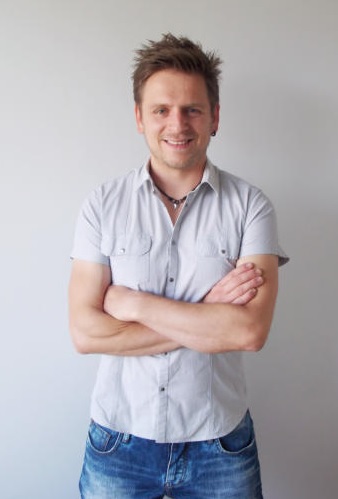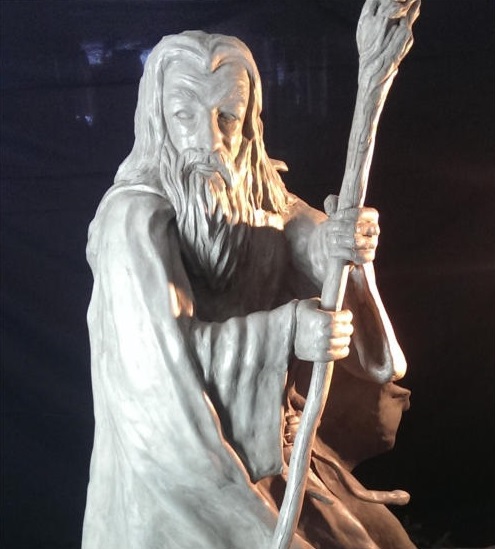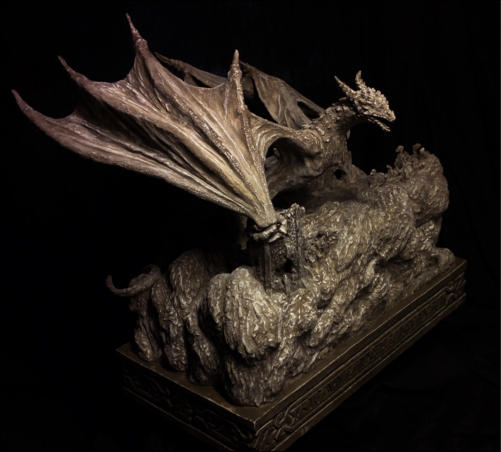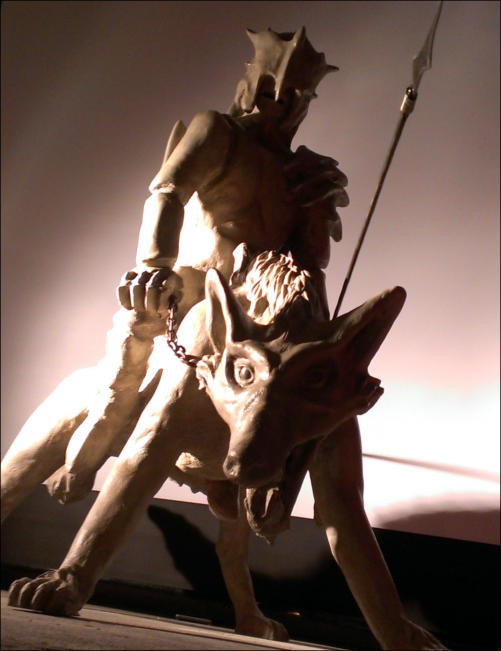Ever since the publication of The Hobbit in 1937, when readers were first introduced to Middle-earth, Tolkien’s creative vision stimulated the imaginations of many artists in the years to come. From music inspired by Tolkien’s poems to several movie and TV adaptations, Tolkien inspired artists expressed themselves in many ways.
Recently, Middle-earth News came into contact with Austrian artist Daniel Nachbaur to talk about his Tolkien-inspired concrete sculptures. In his interview he talks about his process of creating his sculptures and how his love for Tolkien inspires him. The interview was originally conducted in German and was then translated into English. Therefore, after the English translation, you will find the German original.
Disclaimer: I’m not a professional translator which means that some technical terms may not be translated 100% correctly. If any translation seems to be off or incorrectly, please leave us a comment and we will update it.
Interview with Daniel Nachbaur
 Middle-earth News: Tell us something about yourself and your creative journey. How did you start creating cement sculptures?
Middle-earth News: Tell us something about yourself and your creative journey. How did you start creating cement sculptures?
Daniel Nachbaur: I’m 33 years old and I’m from Austria – Vorarlberg. I’m married and have a one year old son named Feanor.
I completed in 2003 an apprenticeship as an qualified machine assembly technician. After my own apprenticeship I worked as an apprenticeship instructor for 3 years. Afterwards, I’ve worked as a control engineer.
I discovered concrete sculptures through my father. He created two 1,5m (4’11 ft) tall cement monks. I paid attention to his methods and thought that one could add more details. In other words, I thought that I could do it better. So I just started creating concrete sculptures and I learn more with every new sculpture.
M-e News: Among your sculptures are some Tolkien-inspired concrete sculptures which suggests that you must be a Tolkien fan. How and when did you discover Middle-earth?
DN: The first time I stumbled upon Tolkien’s world was in 2001 when I saw The Fellowship of the Ring in cinemas. That film sparked a fire inside me so I started to devour the books. The mythology, heroic deeds, and the complexity of that universe took over a large part in my heart.
I’ve read The Silmarillion five times already, although I do prefer the audio-book. I tend to listen to it in my studio when I work.
M-e News: Do you have a favourite work by Tolkien?
DN: Yes, The Silmarillion.
M-e News: Why did you decide to create Tolkien-inspired sculptures?
NB: I was a huge Tolkien fan long before I started working on sculptures so Gandalf was the very first project I did.

M-e News: Are you inspired by other artists when working on your Tolkien-inspired sculptures or do you follow your own imagination?
DN: A bit of both-. I can’t get enough of Ted Nasmith’s, Alan Lee’s, or John Howe’s art so their art does have an influence on my own work. However, I enjoy and use the artistic freedom to follow my own ideas. I love it that my work is a small contribution to bring beings from Middle-earth alive.
M-e News: How does the manufacturing process go? Do you start with sketches or do you start working with the concrete right away?
DN: At the beginning, I just do a rough sketch where I decide on the size and scale of the sculpture. After that, I create prototype using wire frame, construction steel, and a fibreglass net as a base for the concrete. Once the concrete starts to harden, I use a chisel and sandpaper to add the last details. Afterwards, a protective layer, using a ‘stone seal’ varnish, is added to make the sculpture water-proof. By adding that protective layer, my sculptures can be set up outdoors as well.
When I’m working on smaller sculptures, less than 40cm (16 in), I’m using clay to create a mould for a silicone prototype. Then I’ll add the concrete to the silicone mould.
M-e News: Does your original idea change and evolve during the process of making that sculpture or do you stick to your original idea from start to finish?
DN: I tend to get new ideas during the construction process and I end up changing things a lot. I can get lost in details.
M-e News: Your sculptures are rather large and rich in detail. How long does it take, on average, to create a sculpture?
DN: That’s difficult to say. It depends always on the size of the sculpture and I tend to create life-sized ones. So my project “Eglain Tirith I Ered Mithrin” – Verlassene Wacht der Grauen Berg took the longest (over 200 hours).

“Eglain Tirith I Ered Mithrin” by Daniel Nachbaur
M-e News: Is there a character or object in Middle-earth that you’d love to create, but you’re too afraid to do so?
DN: I think that’ll be Galadriel. I don’t think I could re-create her beauty.
M-e News: Your sculptures are exhibited on a regular basis. When and where can we see your wort the next time?
DN: There are currently two sculptures exhibited in Pärkle in Liechtenstein. You can also just visit my studio. Additional exhibitions in the future will be announced on my homepage nachbaurdaniel.com.
M-e News: Do you take commissions or can we just purchase what you sell on your homepage?
DN: Oh, of course, I’m taking commissions! The online store is rather new, I’m constantly busy adding new sculptures to the online store.

A wargrider by Nachbaur
German Original
Erzähl mal kurz etwas über dich und deine künstlerische Laufbahn. Wie bist auf Betonskulpturen gekommen?
DN: Mein Name ist Daniel Nachbaur, ich bin 33 Jahre alt und komme aus Österreich – Vorarlberg. Bin verheiratet und habe einen Sohn Namens Feanor der jetzt 1 Jahr alt wird. Beruflich habe ich 2003 eine Lehre als Anlagen Monteur abgeschlossen, war Lehrlingsausbildner für 3 Jahre und danach bin ich bis 2015 als Steuerungstechniker tätig gewesen.
Auf die Betonskulpturen bin ich über meinen Vater gestoßen. Er hat mit Zement 2 Mönche die ca 1,5 Meter hoch sind hergestellt. Ich habe mir sein Verfahren abgeschaut und gedacht dass man das auch Detailgetreuer machen kann. Beziehungsweise wie ich es besser machen konnte. So habe ich angefangen Skulpturen zu bauen und ich lerne mit jeder neu dazu.
Unter deinen Skulpturen befinden sich auch Tolkien-inspirierte Skulpturen was vermuten lässt das du ein Tolkien fan bist. Wie und wann hast du Mittelerde für dich entdeckt?
DN: Ich bin 2001 zum ersten mal auf Tolkiens Welt gestoßen. Als ich den ersten Teil der Herr der Ringe Trilogie im Kino gesehen habe. Der Film hat in mir ein richtiges Feuer ausgelöst und habe angefangen die Bücher zu verschlingen.
Die Mythologie, Heldentaten und die Komplexität des Universums hat in meinem Herzen ein riesen Platz gefunden. Ich bin habe das Silmarillion schon das fünfte male durch, wobei ich hier das Hörbuch bevorzuge. Höre es mir meist im Atelier bei der Arbeit an.
Hast du ein Lieblingswerk?
DN: Ja, das wäre das Silmarillion
Wie kamst du darauf eines Tages Tolkien-inspirierte Skulpturen herzustellen?
DN: Da ich ein riesen Fan von Tolkien war bevor ich schon mit Skulpturenbau angefangen war Gandalf mein allererstes Projekt das ich ausgewählt hatte.
Lässt du dich bei deinen Tolkien-inspirierten Skulpturen von anderen Künstlern beeinflussen oder folgst du ganz deiner Vorstellungskraft?
DN: Sowohl als auch, ich könnt mich an den Bilder von Ted Smith, Alen Lee oder John Howe nicht satt sehen und haben doch auch einen Einfluss auf meine Arbeiten. Genieße hier jedoch meine Künstlerische Freiheit selbst zu gestalten sehr. Ich liebe es einen kleinen Teil dazu beitragen zu können Geschöpfe aus Mittelerde lebendig zu machen.
Wie genau läuft der Herstellungsprozess ab? Beginnst du mit Skizzen oder beginnst du gleich an dem Beton zu arbeiten?
DN: Am Anfang mache ich nur eine grobe Skizze, an der ich dann die Größe der Skulptur über einen Maßstab festlege. Danach folgt ein Model aus Gitter, Baustahl und einem Glasfassernetz, dass dann mit Beton Modelliert wird. Wenn dieser Beton anfängt auszuhärten werden mit Meisel und Schleifpapier die letzten Feinheiten ausgearbeitet. Abschliessend kommt ein Impregmierung mit einem Steinsiegel die die Skulptur dann Witterungsbeständig macht. Somit können die Figuren auch im Freien aufgestellt werden.
Bei kleineren Figuren die nicht an die 2 Meter groß sind sonder kleiner als 40cm modelliere ich mit Ton und mach daraus eine Gussform aus Silikon um dann anschliessend einen Betonguss machen zu können.
Verändert sich deine Idee im Laufe des Herstellungsprozesses oder folgst du deiner Designidee von Anfang bis zum Ende?
DN: Oftmals habe ich während des Aufbaues neue Ideen und ich ändere sehr oft noch was ab. Ich verliere mich gern im Detail.
Deine Skulpturen sind sehr groß und Detailreich. Wie lange dauert es (durchschnittlich) eine Skulptur zu beenden?
DN: Das ist schwer zu sagen, das hängt immer von der Größe ab und ich baue ja Teils Lebensgroß. Also bei dem Projekt “Eglain Tirith I Ered Mithrin” – Verlassene Wacht der Grauen Berge bin ich bisher am längsten daran gewesen und das waren über 200 Stunden.
Gibt es irgendein Charakter oder Objekt in Mittelerde das du gerne irgendwann umsetzen wollen würdest, aber dich nicht traust?
DN: Ich denke das wäre Galadriel, ich glaube nicht dass ich ihre Schönheit wiedergeben könnte.
Deine Skulpturen werden regelmäßig ausgestellt. Wann und wo wäre das nächste mal das man deine Werke begutachten kann?
DN: Zur Zeit sind 2 Skulpturen im Skulpturen Pärkle in Liechtenstein oder direkt bei meinem Atelier zu besichtigen. Weitere künftige Austellungen würde ich dann auf meiner Homepage angekündigen nachbaurdaniel.com.
Nimmst du auch Aufträge an oder kann man nur die Objekte kaufen die du in deinen Onlineshop stellst?
DN: Klar, ich nehme sehr gerne Aufträge an! Der Online Shop ist relativ neu, ich bin ständig daran Ihn mit neuen Figuren zu erweitern.
For more information on Daniel Nachbaur and his art, go and check out his homepage nachbaurdaniel.com! Maybe you’ll even find a sculpture to add to your Tolkien collection!


